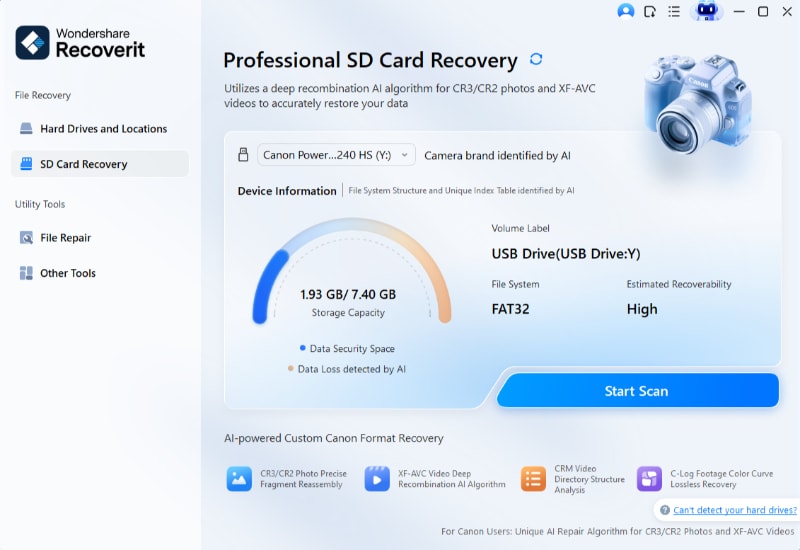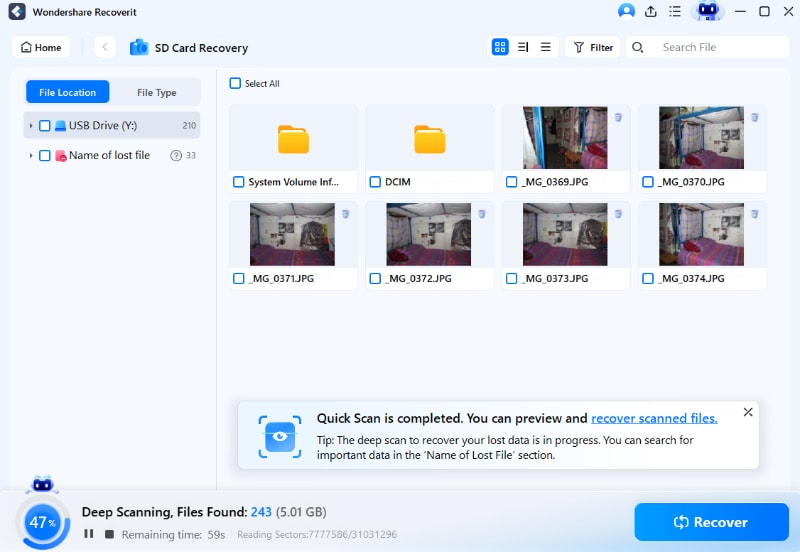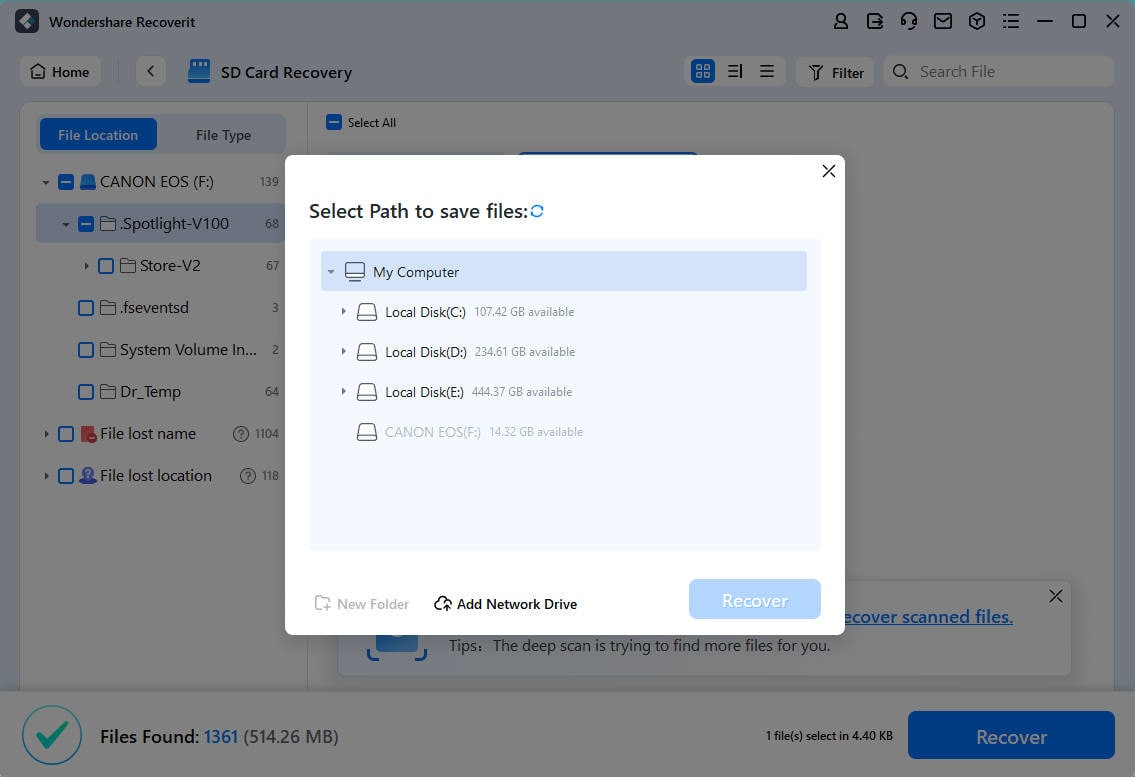Just like any storage device, SD cards have become an integral part of our digital life. Not only do they help us extend the storage capacity on digital devices, but they are also a convenient way to transfer files and documents between devices. However, as with any digital device, SD cards are also prone to errors and issues, especially if you frequently use them to move your files.
One such common error is SD card is blank or has unsupported file system, resulting in it becoming unreadable or undetectable when you connect it to your system. This issue is most prevalent with SD cards used in Android phones, digital cameras, and other portable digital devices. There can be many reasons for blank SD card errors, ranging from hardware faults to software bugs, depending on the usage pattern.
For those who are troubled with blank SD card or unsupported SD card issues, follow along with this article for effective methods to fix the problem. In addition, we have also compiled some of the most typical reasons that cause your SD card unsupported file system or SD card is empty error messages to help find fixes quickly.
In this article
Part 1: Reasons Why SD Card is Blank or Has Unsupported File System Error
While blank SD card or SD card unsupported file system are some of the common errors to face, it is important to analyze the reasons behind them to apply the right fixes. Thus, before moving on to the methods to resolve the issues, you need to first understand the causes for it.
Here are some of the common causes that can result in blank SD card or SD card unsupported file system errors:
- Improper SD Card Removal: If you have removed the SD card from the device in an unsafe way or without turning off the device, then it might result in various errors.
- Virus or Malware Infection: When the SD card is frequently connected to multiple different devices, especially with any device with security issues. This can result in the SD card being infected with Viruses or malware, rendering it inaccessible.
- Different OS Devices: In case you have used the SD card with different operating system devices, the file system of the card can be changed. With the change in the file system, it will show SD card unsupported file system error messages.
- Incorrect Ejection: If you have removed the SD card from your system without properly ejecting it, such as by selecting the "Safely remove hardware" option, it will make it corrupt and unusable.
- File System Compatibility: If you format your SD card in a file system that is incompatible with the device you are using, such as exFAT on an older device that only supports FAT32, the card shows up blank or unsupported.
- Hardware Fault: In a few instances, physical damage to the SD card can lead it to become blank or unsupported. This could be due to severe temperatures, water, or excessive wear and tear.
Part 2: Methods to Fix SD Card is Blank or Has Unsupported File System Problem
Now that you are aware of the possible reasons that cause the SD card is blank or has unsupported file system errors. Here are some of the most effective methods you can apply to fix blank SD card and unsupported SD card problems.
Method 1: Restart the Device
One of the easiest and foremost blank SD card problem solution is to restart your device. Often, the simplest solution can be the most effective method to resolve the issue with an SD card. By restarting your device, you will be rebooting it from the start to fix any temporary bugs or glitches that cause the SD card to show blank or unsupported.
Here are the steps to restart your device to fix the blank SD card issue:
- Close any running applications on your device for safety, then press and hold the "Power" button until the "Turn Off" options appear.
- Depending on the device, either tap on the "Restart" or "Reboot" option.

- The device will automatically restart in a minute or so.
- This approach has been particularly useful for temporary software problems and does not require any technical knowledge. However, it might not fix deeper issues with the SD card.
Method 2: Remove and Reinsert SD Card
Sometimes, if there is any loose connection between the SD card and the slot, it will also cause many issues. It is also possible that the SD card is not properly aligned or inserted into the slot to allow it to read properly. Thus, to fix these issues, you should consider removing the SD card and inserting it back again to check if it is in the slot correctly.
Here are steps to remove and reinsert SD card into your device:
- Turn off your device first, then remove the SD card from your phone safely.
- Check if any dust or particles are hindering the SD card slot and clean the area.
- Give it ten seconds and insert the SD card back into the card slot of your device again.
- Turn off your device and check if you can access the SD card without any error.
- If the issue is not resolved, then repeat the above steps a couple more times to check if the card works properly.
Although this method can help with connection problems, it is critical not to overdo it, since repeated removal and insertion can harm the card or the SD card slot.
Method 3: Check with Other Device
If the SD card is not functioning properly even after reinserting it multiple times, try to connect and check it with a different device to confirm it is working. Or, try to access the SD card by connecting to a different card reader. There is the possibility that the card slot on the device or the card reader you are using is faulty or has issues that are causing the SD card to display blank or unsupported.
Method 4: Using CHKDSK via CMD
If the SD card is empty showing after the simple fixes from above, you can use the Windows build-in check disk feature to solve it. The CHKDSK command on the command prompt can easily scan for any bad sectors on your SD card and repair the file system of the SD card.
Follow the below steps to solve the SD card unsupported file system issue using the CHKDSK feature:
- First, connect the SD card to your computer using the card reader.
- Next, search for "Command Prompt" from the "Start" menu on your Windows PC.
- From the search result, right-click on the "Command Prompt" and select the "Run as Administrator" option.

- On the "Command Prompt" window, enter the "chkdsk X: /f" command and press the "Enter" key. Make sure to replace the "X" letter in the command with the SD card drive letter from the File Explorer.

- Wait until the process is over and exit from the command prompt.
With this method, you can correct any storage errors and file system corruption. Check the SD card if the blank or unsupported error persists.
Method 5: Show Hidden Files on SD Card
Often, if you have hidden files in the SD card, without enabling show hidden files feature on your system, you can not view or access them. You can check your SD card if it contains any hidden files that you are not able to view.
Follow the below steps to fix blank SD card issue by enabling show hidden files option:
- First, connect your SD card to your computer using a card reader.
- Open the "File Explorer" from the "Start" menu and select the "This PC" option from the left side panel.
- Go to the SD card drive in the File Explorer and click on the "View" tab on the top toolbar.
- Next, select the "Show" option from the drop-down list and click on "Hidden items" to enable showing hidden files or folders.

Although it is one of the simplest processes, most users overlook it and forget there are any hidden files in the SD card.
Method 6: Format the Blank SD Card
You can format your memory card to fix any unsupported SD card or SD card unsupported file system issues. It will create a fresh new file system that is compatible with your system while also erasing all the data inside.
Here are the following steps to format the blank SD card to fix SD card is blank or has unsupported file system errors:
- Connect your SD card to your computer via a card reader.
- Click on the "Start" menu and open the "File Explorer" to select the "This PC" option from the left.
- Right-click on the SD card drive and select the "Format" option from the drop-down menu.

- Next, on the format window, select the file system to the "FAT32 (default)" option for the best compatibility. Also, uncheck the "Quick format" option and click on the "Start" button.

- Wait for the formatting process to complete. It will change the file system and erase all the data inside while allowing for overwriting of the files.
Method 7: Using Error Checking Feature
Another easy fix for SD card is empty or SD card unsupported file system errors is by using the Error Checking feature on the Windows computer. The process can fix all the issues related to the file system of the SD card while also resolving any bad sectors in the storage.
Here are the steps to fix blank SD card or unsupported SD card errors using the Error Checking functionality:
- First, connect your SD card to your PC using the card reader properly.
- Open the "File Explorer" from the "Start" menu of the Windows PC and select the "This PC" option from the left panel.
- Select the SD card drive from the list of drives and select the "Properties" option after right-clicking on it.

- On the Properties window, select the "Tools" tab at the top and click on the "Check" option under the "Error Checking" section.

- On the next window, follow the on-screen instructions and select the "Scan Drive" option to automatically fix any errors or issues.

Method 8: Using Recoverit Data Recovery Tool
Assuming none of the methods fix blank SD card problem solution, as a final solution, you should consider using reliable data recovery tools such as Recoverit - Data Recovery. It is cross-platform compatible with both Windows and Mac systems. Also, it can restore practically all file formats and types. The app is one of the most secure and dependable data recovery tools, with the highest recovery rate of lost data. It can also successfully restore lost or deleted files from internal or external storage devices.
Here are the following steps to recover data from a blank SD card or unsupported SD card using Recoverit:
- Download and Install
- First, you need to download and install the Recoverit - Data Recovery application on your computer from its official website.
- Connect SD Card. Connect your SD card with that showing blank or unsupported to the computer using a reliable SD card reader.
- Select SD Card Option. Click on the "Scan" button next to the SD card with a blank or unsupported issue to begin the scanning and recovery process.

- Scanning Process. The application will completely scan the SD card for lost or deleted files that can be recovered using its algorithms. It might take a few minutes to complete, depending on the number of files and file size in the SD card. Wait until the scanning process is over and all the recoverable files from the SD card are displayed as results.

- Preview And Recover
After the scanning is over, all the recoverable files from the SD card will be displayed with the file types and folder locations. You can preview the recoverable files that you wish to retrieve and check if it is correct.
Click on the "Recover" button for the files you want to recover and provide the preferred location where you want to save them. However, ensure not to save the recovered files in the original location of the deleted file.

Conclusion
With the extensive use of SD cards in our devices, we regularly face different kinds of error messages. There are different possible ways to get it resolved depending on the reasons for the error message. Depending on the reasons and error you are facing on your SD card, apply the appropriate method to fix it. However, before proceeding with fixes, it is better to recover the contents from the SD card using the best recovery tool, Recoverit - Data Recovery.
FAQ
-
1. Why is my SD card blank or file system not supported?
There can be many reasons for why your SD card is showing blank or file system not supported error. The reasons can range from a corrupt file system to virus infection. You can go through the above article for a complete reasons list and effective methods to resolve it. -
2. How do I fix unsupported files on my SD card?
You can fix unsupported files on your SD card either by formatting the card to the compatible file system or running the CHKDSK utility on a Windows PC. Follow the above-given methods in the article for all the steps and guides to fix it. -
3. How to format a blank SD card?
You can format your blank SD card by connecting it to your system using a card reader and opening it in File Explorer. Then right-click on the SD card drive and select the Format option to change the file system and format the SD card easily.















